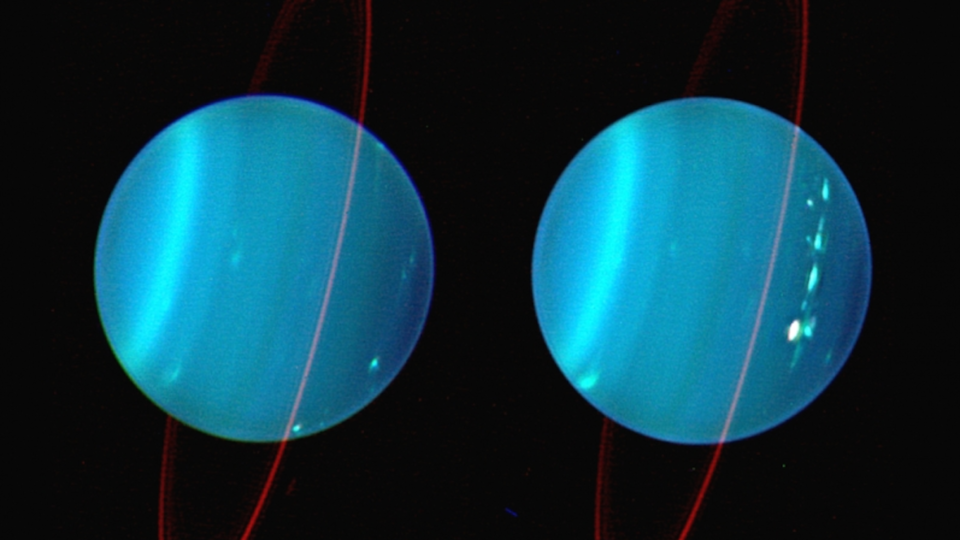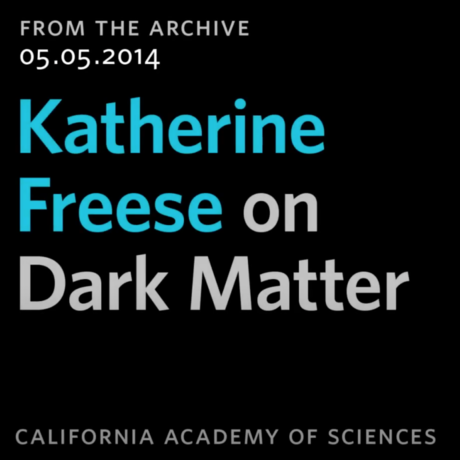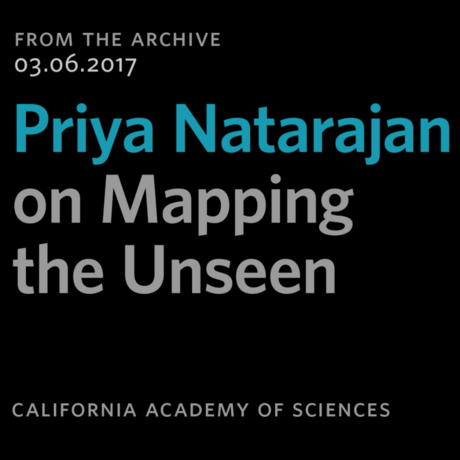Science News
Yes, the Universe is Expanding (and More!)

More Moons for Uranus
In a stellar example of how space exploration missions from long past can find continuing life in the data they provide, a team from the University of Idaho reported this week in The Astronomical Journal evidence of two tiny, previously undiscovered moons around Uranus, a full 30 years after NASA's Voyager 2 conducted its brief flyby of the world.
The seventh planet from the Sun has a number of notable features including its tilt, 27 previously known moons, and narrow rings, the last of which was only discovered in 1977 (coincidentally the same year the Voyager 2 launched). But the rings seemed remarkably narrow, especially in comparison to neighboring Saturn’s sprawling set.
“When you look at this pattern in different places around the ring, the wavelength is different—that points to something changing as you go around the ring. There's something breaking the symmetry,” said Matt Hedman of the University of Idaho.
The presence of two newly discovered mini moons orbiting close to the rings may help explain why Uranus’s rings are so skinny—in fact two other moons around Uranus, Ophelia and Cordelia, are known to act as “shepherds” keeping ring material closer together and preventing it from spreading out. These two moonlets may be doing something similar.
Both Hedman and co-author Rob Chancia are familiar with rings, having previously researched Saturn’s with Cassini data. They found the pattern in Uranus’s rings was similar to moon-related structures in Saturn’s rings called “moonlet wakes.”
The estimated size of the hypothesized moonlets are in fact quite small, from four-to-fourteen kilometers (two-to-nine miles) in radius. That makes them far smaller than any known Uranus moons but not as small as some of Saturn’s.
Confirming the moonlets through observation, however, will be left to other teams—and it may prove a challenge both due to their small size and hypothesized low brightness. In the meantime, Hedman and Chancia will continue to mine Voyager’s data to uncover more of Uranus’s secrets. –Elise Ricard
A Binocular-Visible Nova in Sagittarius
Even as the constellation Sagittarius the Archer sets in the west just after sunset, a newly-discovered nova has become bright enough to be seen with binoculars among its stars—but only barely.
Thought by early astronomers to be “new” stars, novas occur in binary star systems, where one member is a sun-like star and the other a white dwarf—the small, dense end-stage in the evolution of average stars. Orbiting close enough for its gravity to steal hydrogen from its larger companion, the white dwarf collects increasing amounts of the gas onto its surface, building up pressure and temperature. When the temperature reaches about 20 million Kelvins (36 million degrees Fahrenheit), a runaway fusion reaction is triggered that ignites the layer of excess hydrogen, blowing some of it off. As seen from Earth, this explosion makes the star appear to brighten as much as 100,000 times. However, unlike a supernova, where a giant star blows itself to smithereens, leaving its collapsed core, the white dwarf survives the explosion. Thus, it starts the process over again and resumes collecting hydrogen from its companion that will trigger another explosion some years down the road. Most novas are thought to recur at intervals on the order of thousands of years, but one example—RS Ophiuchi—is known to have flared six times, each separated from the next by only one to three decades.
Discovered by a Japanese amateur astronomer Koichi Itagaki on October 20, the new nova is designated TCP J18102829-2729590, a name that incorporates the object’s celestial coordinates so that astronomers will know exactly where to look for it—but there’s an easier way that doesn’t require knowing so many digits.
Look very low in the southwest just after sunset for the “teapot” asterism in Sagittarius. Delta and Gamma Sagittarii—the two stars forming the top of the spout—form an equilateral triangle with the nova above them. However, the nova is still reportedly too faint to be seen with the unaided eye, so observers will need at least a pair of binoculars to see it. Don’t wait too long after dark either, because Sagittarius sets about two hours after the Sun. This type of nova tends to fade in a week or two, so it could start dimming at any time. –Bing Quock
A New Breakthrough in the Search for ET
Late last year, a star under the watch of the Kepler Mission generated a lot of buzz, showing activity unlike any other: a strange and inconsistent dimming that had no known explanation. Many different hypotheses have been offered up to describe the conditions observed at KIC 8462852 (the star’s very catchy moniker): everything from large swarms of comets or interstellar clouds of debris, all the way to rogue black holes. But each possibility brings its own set of caveats and increasing unlikely conditions required to match what we’ve seen around the star. So far there hasn’t been good evidence to point definitively toward any one of these solutions. Due to its odd qualities and stubborn habit of defying natural explanations, it’s possible that Tabby’s Star(as it has been dubbed in honor of the lead scientist on the project that brought it into the spotlight) has a rather unnatural explanation: it could be home to an extraterrestrial megastructure.
As Elise Ricard wrote here earlier this year, it’s been suggested that the dimming could be caused by bunches of solar panel-like structures orbiting around the star in what’s called a Dyson Swarm, a structure similar to the better known Dyson Sphere. These kinds of constructs would be a sign of a highly intelligent civilization working to gather huge amounts of energy from their home stars; the discovery of which would be one of the most important and profound scientific advances ever made, finally answering the question as to whether or not we are alone in the Universe. As the saying goes, however, extraordinary claims require extraordinary evidence, and as it stands all we have to show is a dimming of Tabby’s Star’s light, which while unique and interesting is a distant cry from definitive signs of alien life.
A new project may change that. The Breakthrough Initiative is a collaboration that hopes to find the definitive proof of extraterrestrial intelligence, spearheaded (and fully funded) by entrepreneur and science-minded philanthropist Yuri Milner. Last year Milner introduced the new program alongside Stephen Hawking, including a commitment of $100 million to search for a signal from an advanced alien civilization. One of Breakthrough’s runs this week is dedicated to searching the area around Tabby’s Star in the hopes of catching either an intentional or inadvertent radio signal from the hypothetical aliens living there.
Shortly after the announcement of the star’s strange behavior, the SETI Institute conducted an initial search but detected no signal. Now with support from Milner’s Breakthrough, the search has been greatly enhanced with new instruments attached to the Green Bank Telescope, allowing the team to scan through billions of different radio channels across 12 Gigahertz of bandwidth, using four different radio receivers. Breakthrough will dedicate 25 hours of telescope time toward Tabby’s Star periodically over the next two months collecting an estimated total of one petabyte (or 1,000 terabytes) of data, and capturing more than ten gigabytes worth of radio signal every second.
The team’s hope is that somewhere in that massive tome of data we will find a signal finally confirming that yes, someone else is indeed out there. And if we choose to, we can introduce ourselves to the neighbors down at Tabby’s place.
Breakthrough is committed to keeping its entire library of data, including observations of Tabby’s Star, open to anyone interested. Take a look! –Aaron White
Dark Energy Crisis
If you asked college graduates about their favorite classes, the might say astronomy (at least that’s what astronomy professors would hope). If you asked about their least favorite classes, you might expect that statistics would get mentioned (even by astronomy majors). But it turns out that statistics play a central role in estimating the number of galaxies in the Universe or the number of planets in our galaxy… And statistics also help astronomers asses the validity of their theories. Astronomy students who slept through their statistics classes have some catching up to do!
On Monday, the Oxford Science Blog provocatively asked, “The universe is expanding at an accelerating rate—or is it?” It described a paper published in the Nature journal Scientific Reports with a provocative title of its own: “Marginal evidence for cosmic acceleration from Type Ia supernovae.” The new research basically attacks the idea of the accelerating expansion of the Universe, which was awarded the 2011 Nobel Prize in Physics and led to the predicted existence of dark energy. Ouch! Gauntlet thrown.
And the source of all this drama? Statistics. Statistics on 740 Type Ia supernovae, to be exact. (The initial hint at accelerating expansion came from the observation of such supernovae, through a process described well on the Hubble Space Telescope site.) The authors of the “marginal” paper went back to basics with their assumptions to assess the likelihood that the observed supernovae characteristics result from the accelerated expansion of the Universe. Employing a technique known as maximum likelihood estimation (in contrast to the common chi-squared test), they determined that the data favored the dark energy model only at the “three sigma” level, not at a “five sigma” level that they (like others) consider the gold standard.
Alex Filippenko, Professor of Astronomy at UC Berkeley and Academy Fellow—and the only member of both teams that announced the accelerating expansion of the Universe—made his thoughts quite clear when I asked his opinion of the work. “The 1998 discovery of the accelerating expansion of the Universe, based on analysis of our observations of Type Ia supernovae, has now been corroborated with much additional evidence using several completely different techniques which the present authors inexplicably ignore. When all of the methods are considered, acceleration is confirmed at the five-sigma level, the degree of certainty demanded by these authors. But even if only supernovae are used and one accepts the authors’ assertion that the probability of acceleration is only 99.7% (it actually exceeds 99.99%, as found by other researchers who properly analyzed the supernova data), it is incorrect to conclude that there is no acceleration. Pay no attention to this paper’s conclusion and the media hype surrounding it.”
Media hype indeed. Numerous news sites picked up on the original story—including Phys.org, which released a rather breathless story (well, for Phys.org) on Monday, followed by a more measured piece today.
Basically, in going back to basics with their assumptions, the authors of the paper seem to have thrown the babies out with the bathwater—in this case, the babies being the matter content of the Universe (empty universes aren’t much fun) and the flatness of the Universe. As a paper posted yesterday announced, combining multiple lines of evidence for dark matter yields something like “75 sigma” evidence in favor of the hypothesis. Kinda puts the “five sigma” challenge to shame…
If you’re looking for a thorough disentangling of the provocative claim, I’d recommend the Scientific American blog post by Dan Scolnic and Adam G. Riess or the step-by-step debunking on Ethan Siegel’s Starts With A Bang blog. No statistics required. –Ryan Wyatt


